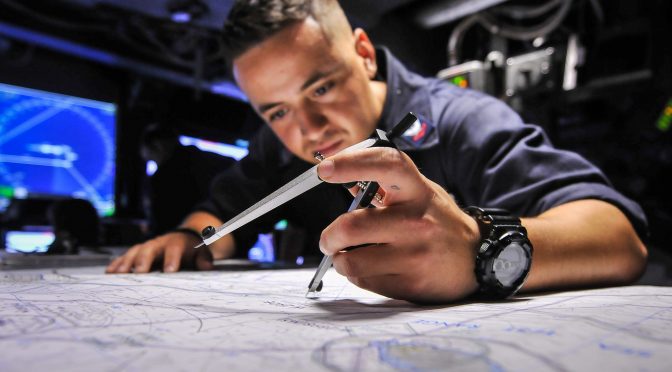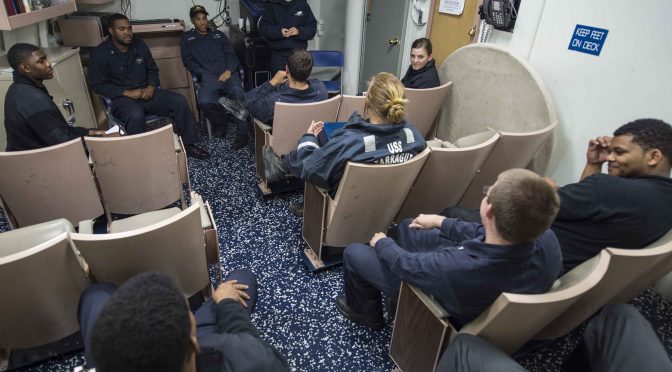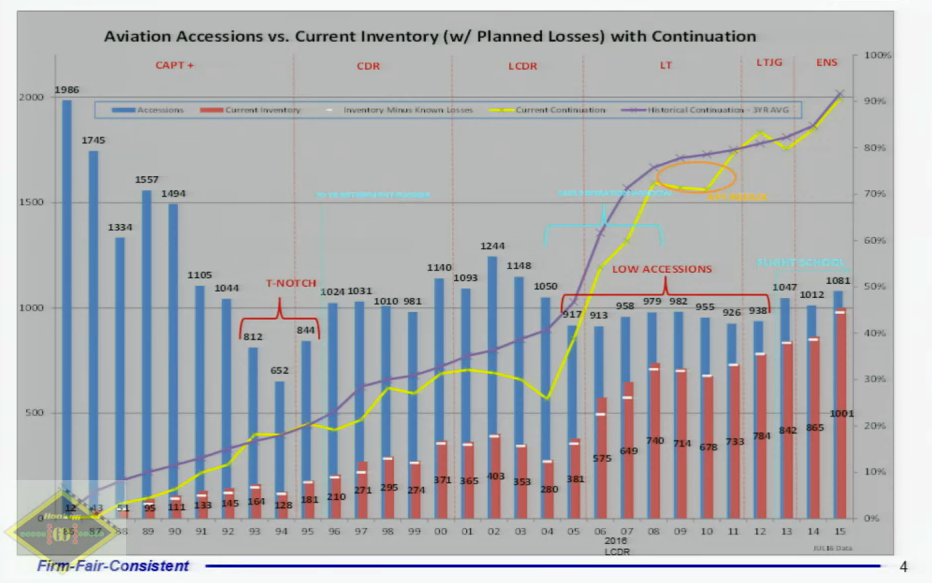Leadership Development Topic Week
By CDR Will Wiley
“For in this modern world, the instruments of warfare are not solely for waging war. Far more importantly, they are the means for controlling peace. Naval officers must therefore understand not only how to fight a war, but how to use the tremendous power which they operate to sustain a world of liberty and justice, without unleashing the powerful instruments of destruction and chaos that they have at their command.” These words delivered in 1961 by then Chief of Naval Operations (CNO) Admiral Arleigh Burke ring as true in 2017 as they did when he uttered them during his Change of Command address. Leaders today must be expert operators on technologically advanced submarines, ships, and aircraft. They must operate these platforms on seas and in skies which are increasingly more crowded and cluttered. They must motivate their teams to accomplish the assigned mission and serve as effective ambassadors for the nation during foreign port calls. Additionally, leaders are challenged to motivate their subordinates to follow in their footsteps and pursue a career in the Navy. Finally, they must make quick decisions about how to respond to aggressive peer competitors without having the luxury of discussing it with their superiors. Some of these challenges come naturally to those in leadership positions, but taken in total, Navy leadership in 2017 is difficult for even the most prepared leader.
Therefore, it is wise to analyze the question, “Does the Navy equip its officer and enlisted leaders, at all levels, to meet the challenges faced on any given day in America’s Navy?” The recent release of the Navy Leader Development Framework provides a guide for leaders to develop themselves in a world “that is changing quickly and becoming more complex.” However, the Framework, signed by CNO Admiral John Richardson, leaves the details to each naval warfare community to determine the specifics on how it develops their leaders over a career.
These warfare communities do an outstanding job of making the individual a master of their craft, be that as a submariner, surface warfare officer, naval aviator, SEAL, etc. The Command Leadership School, Senior Enlisted Academy, and other Navy leadership courses develop the individual for the leadership and character challenges they will face in their upcoming job. Informal mentorship, personal development, and experience further prepares the individual for leadership positions. But there are areas where this leadership development is lacking. This paper will suggest some items for consideration to improve the leaders of today and tomorrow. Some will require funding streams, while others just require forethought and creativity by the leader. These recommendations, when coupled with the immense amount of formal training leaders receive, can make the Navy an even more formidable force today and in the future.
Leaders are Warfighters
Above all else, the job of a naval leader is to prepare to fight and win the nation’s wars. Too often in the daily grind of processing paperwork, preparing for an operational inspection, or conducting routine maintenance tasks, leaders forget the reason the nation has a Navy and why they serve. Captain John Paul Jones was not obsessing over getting fitness reports turned in on time when he said in 1778, “I wish to have no connection with any ship that does not sail fast for I intend to go in harm’s way.” Most individuals who join the Navy do so to operate the amazing platforms used by the fleet today. They desire to fly planes and drive ships rather than sign their name or make powerpoint briefs.
While there is a time and place for mundane tasks, leaders must constantly remind their team they are working toward an important mission. This mission is not training for the next major inspection, but rather preparing for forward deployment or combat operations. Leaders must look for opportunities in peacetime training environments to simulate these operations. This can be done in simulators or on the actual platform. Place the team in a realistic scenario and challenge them as they would be challenged in combat or on a deployment. This will tap into the reason most of the individuals joined the military and will produce a better team ready to execute forward deployed operations.
Each warfare community in the Navy has a rich history leaders must pass to the next generation. Leaders should look for creative ways to infuse these stories into the daily routine of a command to motivate the team. Whether it be the VIRGINIA-class submarine crew reading a World War II submarine war patrol story before every engineering training or the crew of the USS ZUMWALT reading about the Battle of Midway throughout the year rather than just during the Battle of Midway celebration, the important thing is to consistently remind sailors in 2017 about the gallant exploits of their predecessors.
Leaders should not only use history to their advantage, but also celebrate the work other ships in the fleet are doing today. Inviting counterparts from a returning deployer to share their experiences with your team will motivate a command to complete the numerous tasks required to begin a deployment. In the submarine force, there are stories of World War II submarine commanding officers describing experiences to each other from their war patrols over beverages on a Friday afternoon. Too often today these discussions are forgone due to packed schedules. However, an argument could be made that they will do more to prepare the leader for the upcoming mission or deployment than anything that is keeping the individual on the ship.
It is easy for leaders to focus on paperwork, rewrite radio messages, or improve powerpoint animation. None of these items will win the next engagement with the enemy and they do not motivate a team to work long hours to prepare for a deployment. Therefore, leaders must use creativity and a little bit of planning to put the team into realistic situations and consistently remind them of what they may be asked to do many nautical miles away from homeport.
Leaders Must Read
With the end of the Cold War in 1989, the world shifted from a relatively easy-to-understand bipolar international system dominated by the U.S. and Soviet Union to a more complex, multi-polar global community. In recent years, a resurgent Russia has taken aggressive action toward U.S. Navy ships and aircraft with desires to reclaim its place as a dominant world power. China is expanding its military and area of influence with its island building campaign in the South China Sea. The Middle East remains a tumultuous region. Non-state terrorist organizations like ISIS and Boko Haram continue to further their aims.
The scene described above is just a small taste of the world where the naval leader conducts operations in 2017. The only certainty is that it will change. Therefore, the leader must stay abreast of this environment through consistent reading of current events. The CNO has an excellent reading list, which should be utilized, but it cannot be the sole source of information. Books that make this list and other reading lists often lag world events. To stay up-to-date about the challenges in the world, leaders should consume a daily newspaper like The New York Times, Washington Post, or Wall Street Journal and a weekly news magazine like Time or Newsweek. Many of these publications focus on domestic issues, while a periodical like The Economist offers a more international perspective. This consistent study will be helpful for leaders who find themselves overseas often and must understand U.S. domestic policies and the challenges facing the international community.
It is also important for the leader to have multiple news sources with differing political leanings. Subordinates and fellow leaders may filter out unwanted viewpoints or facts in the news. Leaders must be aware of the differing views about a story and use multiple sources of information to understand it and effectively communicate it to their subordinates.
As a young LTJG on a submarine conducting TLAM operations during the opening moments of Operation IRAQI FREEDOM, I remember being asked by several of my subordinates why we were conducting these operations. I relied heavily on my U.S. Naval Academy and Georgetown University education, but I also used my reading of news periodicals to properly answer this question. Therefore, leaders must commit to a steady diet of information about the world.
Finally, the leader should realize the periodicals and newspapers listed above will keep the leader informed of world affairs as they develop, but may not always offer the in-depth analysis on global trends or the world leaders who shape the landscape of geopolitics. To bridge this gap, leaders can choose from a wide range of writing from foreign policy experts located in academia and the think tank community. Professional military journals like USNI’s Proceedings are also a good source of information and analysis. Additionally, full-length books by respected historians or experts can round out the leader’s need for insight.
The world is a dynamic place in 2017 and will not become simpler in the years ahead. Therefore, leaders must develop a reading plan to understand the complex planet where they conduct operations.
Leaders Should Leverage Social Media and Smartphone Technology
In some form, a social media platform is in the hand of almost every member of the Navy and is being used on a smartphone. Therefore, ignoring the technology or choosing not to deal with it as a leader is unwise. The young Sailors in the fleet and even some of the not so young Sailors do not remember a world without a smartphone or Facebook. Leaders would be wise to leverage the connectivity of a smartphone and ease of use of social media to run a more effective command.
Below is just a short list of how social media and smartphone technology could be employed at a Navy command:
- Use a private Facebook group as a means to recall a crew in port.
- Use a private Facebook group to disseminate information to crew members and family members.
- Create an Instagram or command Facebook page to highlight awards, community service projects, etc.
- Create a command You Tube channel to live stream award presentations or shipwide activities.
The above ideas can be tailored to any level of the chain of command. Leaders receive minimal formal training on how to use these platforms with the exception of a reminder to not violate Operational Security (OPSEC) rules. Once leaders develop best practices they should filter lessons learned up the chain of command for distribution across formal leadership courses. Navy Personnel Command could create a feedback email address to allow the fleet to explain their creative uses of these platforms. In the meantime, leaders should figure out how best to use the social media and the smartphones already in every Sailor’s hands.
Leaders Must Understand the Cyber Domain
Adversaries will continue to look for ways to infiltrate military platforms using the cyber domain. This military domain is not uncharted territory for the Navy, but future conflicts will be just as heavily contested in the cyber domain as they were in the air, land, and sea in the past. Therefore, leaders must understand this domain and how their platform can remain secure from attack while using it to exploit the adversary’s cyber vulnerabilities. The U.S. Naval Academy is teaching all midshipmen a cyber curriculum, which is an excellent first step to equip leaders with a basic level of knowledge about the uses of cyber. However, the Navy needs to expand its efforts to ensure it is in each warfare community’s formal schools. Too often, leaders divest their cyber responsibilities to someone else, but as future conflicts occur in this domain they cannot simply say someone else will handle that part of the battle.
Leaders Can Improve Personnel Management
The individuals who voluntarily decide to serve in the Navy are the service’s most valuable assets. John Paul Jones said, “Men mean more than guns in the rating of a ship.” However, leaders often overlook or minimize the importance of helping Sailors manage their own careers. Often, senior officers provide career management advice to junior officers in the same community due to familiarity with the process. However, officers often fail the enlisted personnel who serve under them by not fully understanding enlisted personnel policies, which are somewhat different from the officer personnel rules. Considering about 85 percent of the personnel in a command are enlisted, it is imperative to fully understand more about the enlisted personnel system.
Individual communities are attempting to improve the personnel level of knowledge in the force, but what would help leaders at all levels is simply putting at their fingertips knowledge of when critical career milestones are occurring or must be decided on by their subordinates. A tailorable iOS or Android application with an associated desktop program could be used by any member of the command to access this information from the Navy personnel system. Imagine if the Executive Officer (XO) of a command could see on one application, who was transferring within the next three months, who was arriving within the next three months, which Sailors are eligible for a Selective Reenlistment Bonus (SRB) and how much that bonus could be, and where 1306 requests or Planned Rotation Date (PRD) extensions are in the personnel systems. Currently, a member of the ship’s office tries to build this information for the XO by logging on to various personnel systems for the information.
Leaders could use this same technology throughout the chain of command with the leader’s viewing permissions limited to their subordinates. The individual Sailor could also use the application to see their own information and make wise career decisions. This technology would not be expensive and efforts such as the Billet Based Distribution (BBD) system are welcome upgrades to the personnel system, but the leader needs it to be much more accessible.
Leaders Should Master Task Management
This paper has explained some of the myriad of challenges facing a leader in today’s Navy. Without a method to process tasks and understand which ones require action a leader will fail. Surprisingly little time in Navy schools is used to teach a leader how to manage daily, weekly, monthly, or annual requiring tasks. It is left to the individual to just figure it out. Some do, others require significant oversight to execute these tasks, while some simply fail. Most leaders fail not because they cannot pilot the aircraft or drive the ship, but instead due to their inability to effectively manage their area of responsibility at the command. The breakdown here seems to be between the first and second sea tour for both officer and enlisted personnel. The first sea tour is relatively easy to manage. These leaders are not leading many subordinates and the task list can be managed in their head. When the individual gets to the second sea tour, there are more responsibilities than can be remembered without a task management system.
There are numerous task management systems an individual can employ, but one worth highlighting is described in David Allen’s book Getting Things Done. In this book, Allen teaches how to process tasks confronting leaders on a daily basis. He also teaches leaders how to generate a recurring task list in a trusted system. The concepts allow you to get mundane task lists out of your mind and free it to do more important things. For the military leader, these concepts free you to be the better mentor or leader to your subordinates and focus on vital tasks like succeeding on the upcoming mission. One does not have to follow the teachings of David Allen to the letter, but in order to succeed in the Navy, leaders must have a trusted task management system before the second sea tour.
Conclusion
The Navy Leader Development Framework is the first step in the work to improve leadership at all levels of the chain of command. However, the world is moving too fast and the challenges facing a Navy leader in 2017 are too great to wait for the development of the perfect Navy leadership course to serve as the panacea for the fleet. Most of the recommended improvements written here require very little money, but if implemented, will reap large dividends for the leader who chooses to employ these strategies. Therefore, leaders should look for ways to employ these strategies to improve themselves and their command. As CNO Richardson said in the Framework, “Let’s get to it.”
Will Wiley is the U.S. Navy Senior Fellow at the Atlantic Council and a submarine warfare officer in the U.S. Navy. The opinions expressed here are the author’s and do not represent the official position of the U.S. Navy, Department of Defense, or the U.S. Government.
Featured Image: MEDITERRANEAN SEA (Oct. 13, 2016) Vice Adm. James Foggo III, Commander U.S. 6th Fleet, addresses the crew of USS Ross (DDG 71) Oct. 13, 2016. (U.S. Navy photo by Petty Officer 1st Class Theron J. Godbold/Released)







